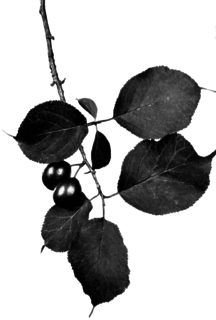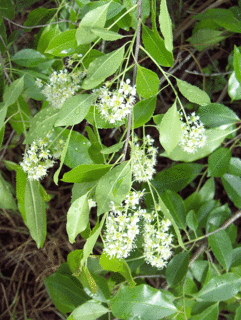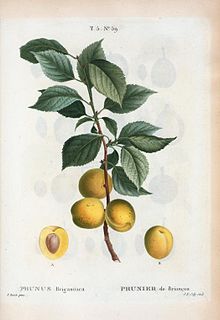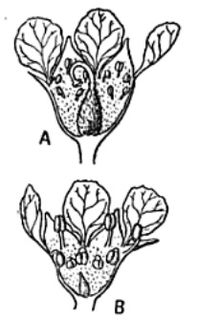
A plum is a fruit of some species in Prunus subg. Prunus. Mature plum fruits may have a dusty-white waxy coating that gives them a glaucous appearance. This is an epicuticular wax coating and is known as "wax bloom". Dried plums are called prunes, which have a dark, wrinkled appearance.

Prunus is a genus of trees and shrubs, which includes the fruits plums, cherries, peaches, nectarines, apricots, and almonds.

Prunus spinosa, called blackthorn or sloe, is a species of flowering plant in the rose family Rosaceae. It is native to Europe, western Asia, and locally in northwest Africa. It is also locally naturalized in New Zealand, Tasmania and eastern North America.

Prunus virginiana, commonly called bitter-berry, chokecherry, Virginia bird cherry, and western chokecherry, is a species of bird cherry native to North America. The natural historic range of P. virginiana includes most of Canada, most of the United States, and northern Mexico.

Prunus padus, known as bird cherry, hackberry, hagberry, or Mayday tree, is a flowering plant in the rose family. It is a species of cherry, a deciduous small tree or large shrub up to 16 metres (52 ft) tall. It is the type species of the subgenus Padus, which have flowers in racemes. It is native to northern Europe and northern and northeast Asia, and is grown as an ornamental in North America.

Syzygium cumini, commonly known as Malabar plum, Java plum, black plum, jamun or jambolan, is an evergreen tropical tree in the flowering plant family Myrtaceae, and favored for its fruit, timber, and ornamental value. It is native to the Indian Subcontinent, adjoining regions of Southeast Asia, including Myanmar, Sri Lanka, and the Andaman Islands. It can reach heights of up to 30 metres (98 ft) and can live more than 100 years. A rapidly growing plant, it is considered an invasive species in many world regions.

Prunus salicina, commonly called the Japanese plum or Chinese plum, is a small deciduous tree native to China. It is now also grown in fruit orchards in Vietnam, Korea, Japan, Israel, the United States, and Australia.

The bullace is a variety of plum. It bears edible fruit similar to those of the damson, and like the damson is considered to be a strain of the insititia subspecies of Prunus domestica. Although the term has regionally been applied to several different kinds of "wild plum" found in the United Kingdom, it is usually taken to refer to varieties with a spherical shape, as opposed to the oval damsons.

Spondias purpura is a species of flowering plant in the cashew family, Anacardiaceae, that is native to tropical regions of the Americas, from Mexico to Brazil. It is also very common in most of the Caribbean islands. It is commonly known as jocote, which derives from the Nahuatl word xocotl, meaning any kind of sour or acidic fruit. Other common names include red mombin, plum, purple mombin, hog plum, ciriguela, ceriguela, seriguela, siriguela (Brazil) ciruela huesito (Colombia), ciruela, ciruela traqueadora (Panama), ciriguela, cirigüela, cirguela, cirguelo (Ecuador), and siniguelas (Philippines). It is a popular fruit throughout Central America, particularly in El Salvador, Nicaragua, Honduras and in Costa Rica.

Prunus nigra, the Canada plum, Canadian plum, or black plum, is a species of Prunus, native to eastern North America from Nova Scotia west to Minnesota and southeastern Manitoba, and south as far as Connecticut, Illinois, and Iowa. It formerly also grew in Ohio but is now thought to be extinct in that state. Isolated populations are present along streambanks in Saskatchewan and Alberta, along Lake Timiskaming in northern Ontario, and along the Maine-New Brunswick border, though this latter population is now severely threatened as the tree is a host for an aphid that menaces the local potato crop and so many of the trees have been cut down.

Prunus americana, commonly called the American plum, wild plum, or Marshall's large yellow sweet plum, is a species of Prunus native to North America from Saskatchewan and Idaho south to New Mexico and east to Québec, Maine and Florida.

Prunus caroliniana, known as the Carolina laurelcherry, Carolina cherry laurel, cherry laurel, or Carolina cherry, is a small evergreen flowering tree native to the lowlands of Southeastern United States, from North Carolina south to Florida and westward to central Texas. The species has also escaped into the wild in a few places in California.

Prunus angustifolia, known commonly as Chickasaw plum, Cherokee plum, Florida sand plum, sandhill plum, or sand plum, is a North American species of plum-bearing tree. It was originally cultivated by Native Americans before the arrival of Europeans. While Prunus is the classical name for European plums, angustifolia refers to its narrow leaves.

Prunus brigantina, called Briançon apricot, Briançon plum, marmot plum, and Alpine apricot, is a wild tree species native to France and Italy. Its fruit is edible and similar to the commercial apricot P. armeniaca, but it is smooth unlike apricots. An edible oil produced from the seed, 'huile des marmottes', is used in France.

Prunus hortulana, called the hortulan plum and wild goose plum, is a fruit shrub in the rose family found in the central United States in: Arkansas, Iowa, Illinois, Indiana, Kansas, Kentucky, Massachusetts, Maryland, Missouri, Nebraska, Ohio, Oklahoma, Tennessee, Texas, Virginia, West Virginia. Populations east of the Appalachians probably represent naturalizations.
Prunus havardii, called Havard's wild almond or Havard's plum, is a rare North American species of shrub tree native to western Texas in the United States and to northern Chihuahua across the Río Grande in Mexico. It is in the genus Prunus in the rose family, Rosaceae.

Prunus glandulosa, called Chinese bush cherry, Chinese plum, and dwarf flowering almond, is a species of shrub tree native to China and long present in Japan. It is commonly used as an ornamental tree and for cut flowers.

Prunus texana, called peachbush, Texas almond cherry, Texas peachbush, sand plum, peach bush, and wild peach is native to central and western Texas. Although it looks like peach, it actually belongs to Prunus sect. Prunocerasus together with other North American plum species.

Prunus gracilis, called the Oklahoma plum, sour plum, and sand plum, is native to the south-central United States.

Prunus minutiflora, called the Texas almond, is a shrub native to Texas and northern Mexico.






















